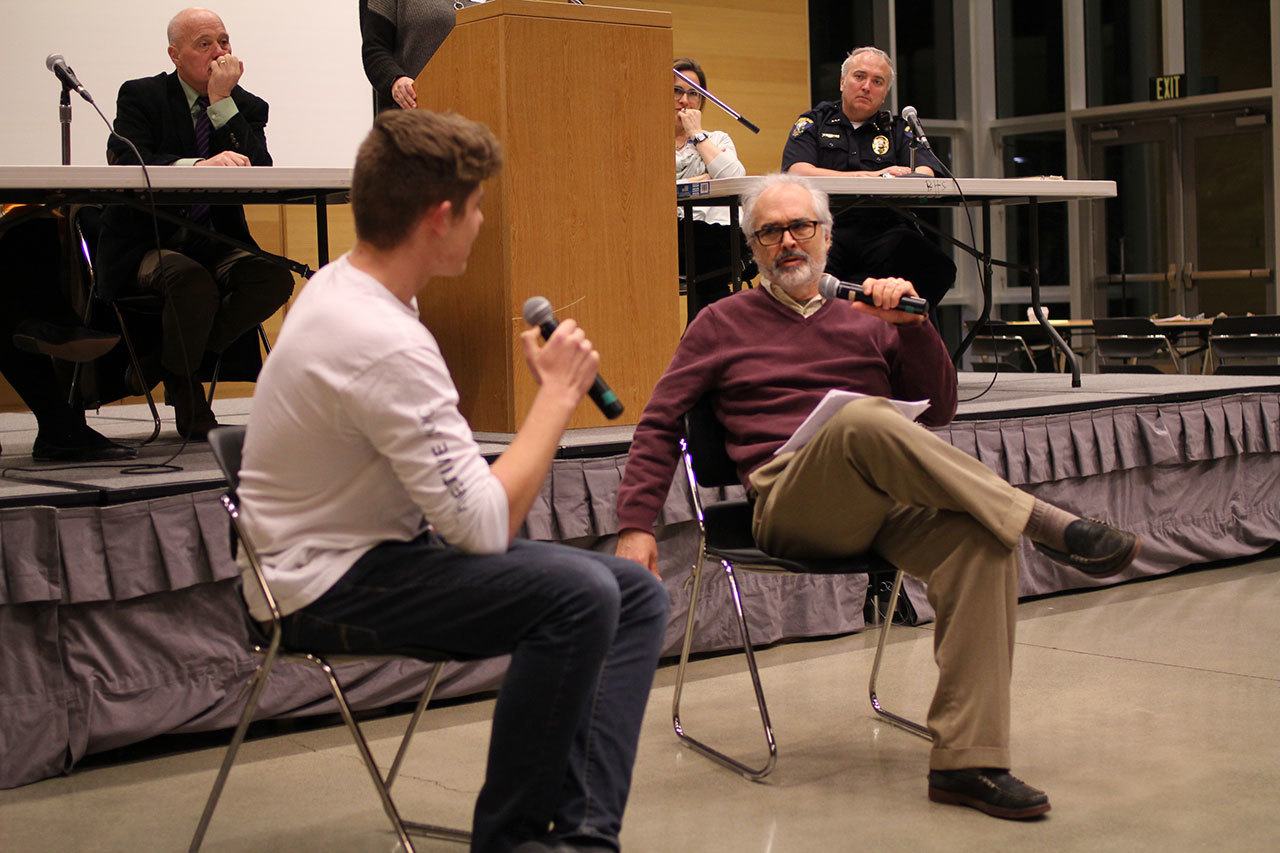Hundreds of concerned parents flooded the Bainbridge High School Commons to learn about how they can better protect their children from drug and alcohol abuse.
Bainbridge High School hosted “What’s the Harm?” on Tuesday, a discussion panel on teen drug and alcohol abuse. The evening’s featured panelists were Kevin Haggerty of the University of Washington School of Social Work; Bainbridge Police Chief Matthew Hamner; Dr. Jillian Worth, a family physician at Virginia Mason Medical Center; and Nicole Hayford, a sexual assault coordinator for Naval Base Kitsap and intern therapist with Bainbridge Youth Services.
According to Hamner, marijuana and alcohol are the most frequently used substances encountered by officers on the island.
“In 2016, there were 23 incidents that we were made aware of where minors were either consuming alcohol or exhibiting the effects of alcohol or someone was supplying alcohol to a minor,” Hamner said.
“Of these 23 incidents, only three of them took place in a park. The rest of the incidents took place at a private residence during a party and most commonly without any parental supervision,” he said.
Hamner focused heavily on the lack of adult oversight during these instances, expressing concern for what could happen to young people who become dangerously intoxicated.
In the last 18 months Hamner recalled entering homes where these teen parties were being held, only to find young people unconscious from heavy alcohol consumption.
Even more troubling than the alcohol abuse, he said, is the potential for teenagers to get their hands on prescription opioids like oxycontin and then combine them with alcohol.
“These percocets, valiums, oxycontin that we take as painkillers and leave in our medicine cabinets or we have our parents or grandparents in the house that take them and then they leave. They can’t remember how many tablets were in the bottle or how many were left. So these kids are smart, they take just enough so that you don’t really know if you’ve taken any,” Hamner said.
“You mix those with the alcohol and that becomes a very scary situation,” he said.
But what about marijuana? Some may think it couldn’t pose a serious threat to teenagers, not true, Hamner said.
According to the police chief, the marijuana of yesteryear pales in comparison to modern day pot. In some cases the marijuana strains sold at recreational stores can be 10 times stronger than the pot from 30 years ago. This is especially important considering that marijuana use has been shown to impede brain development in young people.
“The younger that young people begin using, the more likely it is they’ll become addicted,” said Haggerty. “What I’m really interested in is preventing addiction, not preventing use when they’re adults. If people want to use marijuana and alcohol when it’s legal, when they’re adults, that’s great. I don’t want them to become disabled from addiction.”
It is because young people are more likely to become addicted that Haggerty believes it is important for parents to talk with their children about drugs and alcohol early on. Delaying the age of initiation can decrease their likelihood of developing an addiction, he said.
Worth underscored the doctor’s comments with an anecdote from her own experience as a physician.
“I have a patient who’s 19; she’s been drinking since she was 12. Her family are drinkers, she thinks it’s pretty normal and she still argues with me at every visit about, ‘What’s the harm? So I drink half a bottle of wine every day, so does my mom.’
”The problem is that this 19-year-old girl can’t succeed in college because she doesn’t have a great memory because her prefrontal cortex didn’t wake up yet. That’s the harm,” Worth said.
The event was sponsored by Bainbridge Island School District in partnership with Bainbridge Youth Services, Raising Resilience, Bainbridge Healthy Youth Alliance and the Rotary Club of Bainbridge Island.


